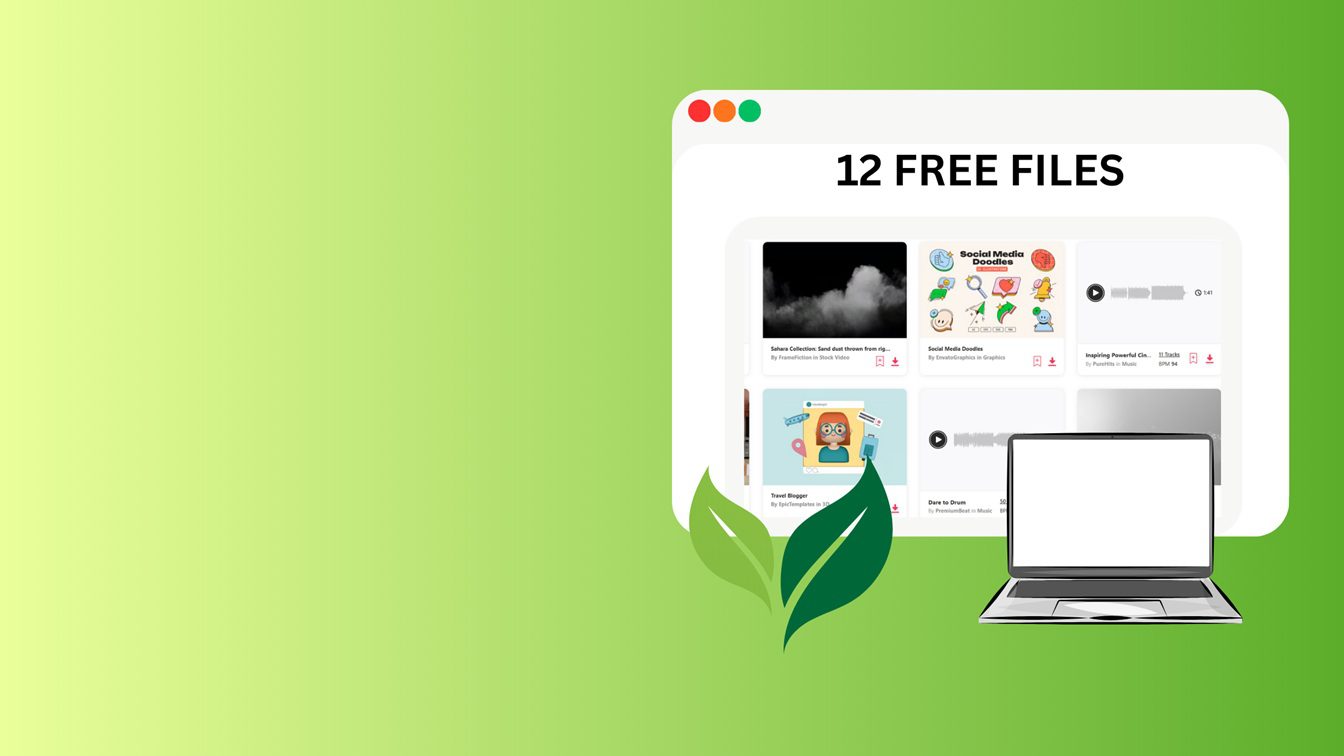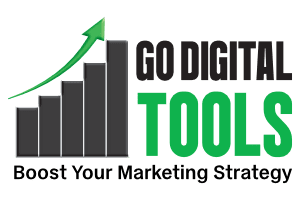To automate affiliate marketing in 2025, use email tools like Mailchimp, social schedulers like Buffer, and platforms like Scaleo for managing affiliates. Add ClickFunnels for landing pages, Feedly for content ideas, Pretty Links for tracking, and run retargeting ads via Facebook. Connect everything with CRMs like HubSpot, integrate Stripe or Paddle for funnel tracking, and monitor results using dashboards like DashThis.
Affiliate Disclaimer: This post contains affiliate links that may earn us some commission without any extra cost to you that will help us to grow, kindly support us! Kindly read our “Affiliate Disclosure” for details.
I can still clearly recall when I first heard the term “automate affiliate marketing.” Half-expecting to come across another overhyped sales pitch, I was browsing YouTube late at night. Instead, I discovered a real breakdown of how automation was enabling people to earn passive income while they slept, traveled, or even just drank coffee. I was interested in that.
By 2025, affiliate marketing has changed more than I could have ever predicted. These days, manual methods simply cannot keep up with the competition. You’re likely losing a lot of money if you’re still managing each email, post, and link by hand
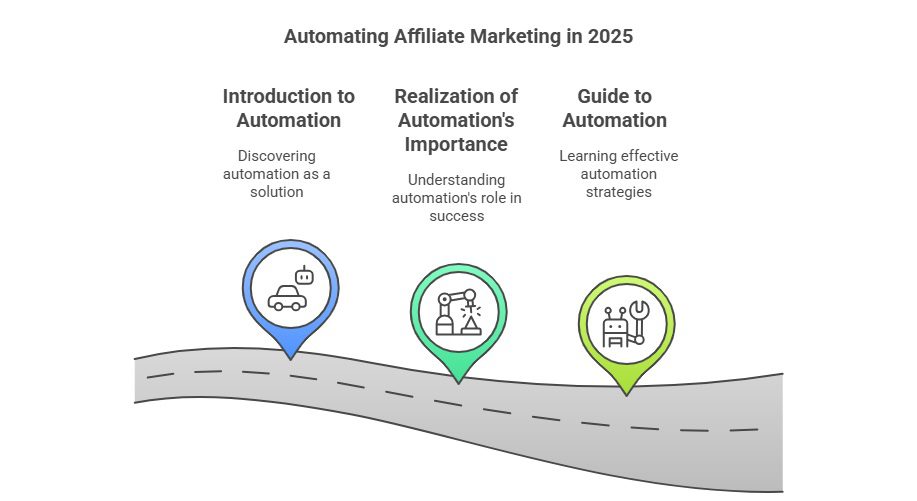
Automation in affiliate marketing isn’t just a “nice-to-have” anymore — it’s the backbone of every successful affiliate business today. Whether it’s scheduling social media content, managing affiliate links, or sending out targeted email sequences, automation helps you work smarter, not harder.
In this guide, I’ll Walk you through how to automate affiliate marketing effectively in 2025. We’ll explore tools, systems, and strategies that make automated affiliate marketing not only possible but powerful. So, if you’ve been searching for a smarter, automated way to run your affiliate biz, you’re in the right place.
What Does It Mean to Automate Affiliate Marketing?
Let’s break it down — automating affiliate marketing means using software, tools, or workflows that handle the repetitive, day-to-day tasks of your affiliate business without you having to do them manually every single time.
Think of things like email follow-ups, affiliate link tracking, social media scheduling, content updates, and even customer support. Instead of juggling all these tasks on your own, automation systems take care of them for you — saving time, reducing errors, and keeping things running 24/7.
| Manual Method | Automation |
|---|---|
| Manually writing emails one by one | Auto responder writes email to your clients. |
| Checking clicks and conversions in spreadsheets | Auto Pilot does everything for you. |
| Constantly logging in just to post content | Automation sets you free from this task. |
This allows you to focus on strategy, building relationships, and scaling your business — the things that truly run the show.
In short, it’s an automated way to scale affiliate income without burning out or missing out. And the best part? The tools in 2025 make this easier than ever before.
Absolutely! Here’s the full content in the Section below: Key Areas Where You Can Automate Affiliate Marketing, broken into step-by-step sub-sections with tools and examples.
Key Areas Where You Can Automate Affiliate Marketing (Step-by-Step)
To fully embrace the power of automated affiliate marketing, you need to understand the key areas where automation can save time, boost efficiency, and increase your revenue. Here’s a step-by-step breakdown of where and how you can start automating your affiliate business in 2025.
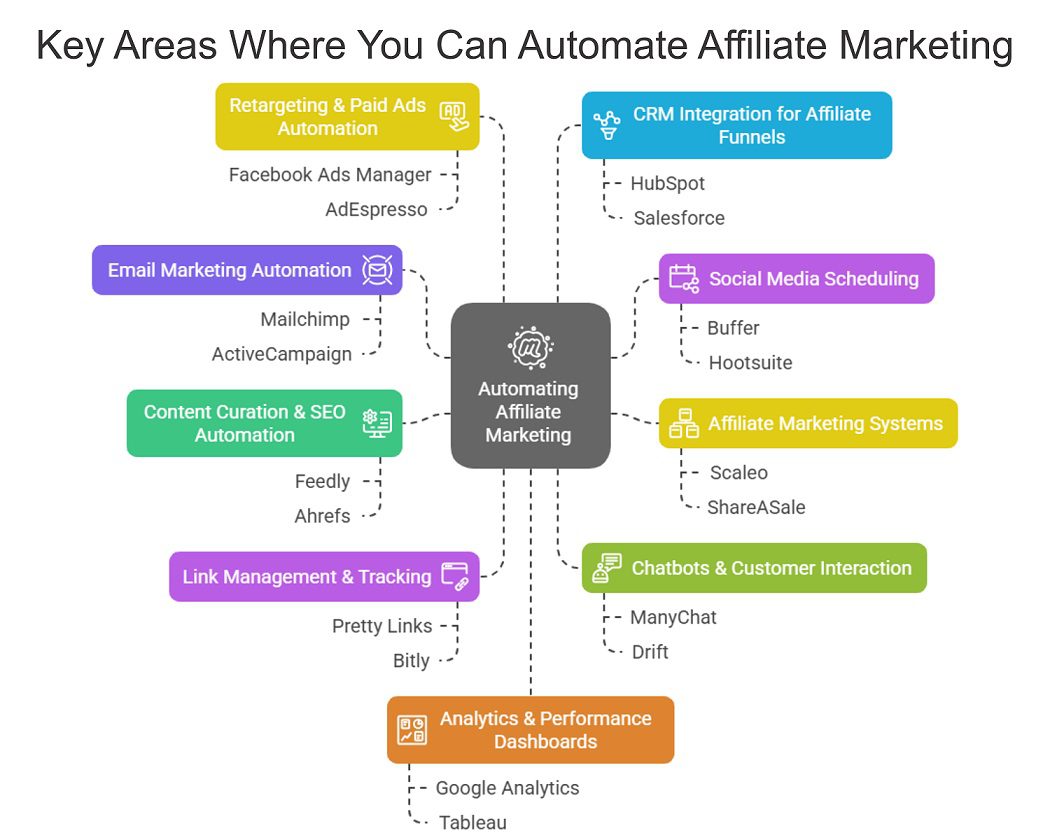
Email Marketing Automation
Email is still king when it comes to affiliate conversions. Automating your email marketing allows you to nurture leads, convert prospects, and re-engage past visitors — all without lifting a finger after the initial setup.
Tools like Mailchimp and ActiveCampaign make it easy to create automated sequences based on user behavior. For example, you can set up a welcome sequence for new subscribers, a product recommendation series based on past clicks, or even re-engagement emails for inactive users.
💡 Pro Tip: Set up segmentation tags in ActiveCampaign to tailor offers based on user interests — this drastically improves open and click-through rates.
Social Media Scheduling
Posting content manually every day? It’s a drain on your time and creativity. With automation tools like Buffer or Hootsuite, you can batch-create your posts for the week (or month) and schedule them to go out automatically across all your platforms.
Buffer vs Hootsuite – a basic comparison
If you are beginner, I’d suggest to start with Buffer, my personal favourite, as it offers a lifetime free plan with basic features required by a newbie.
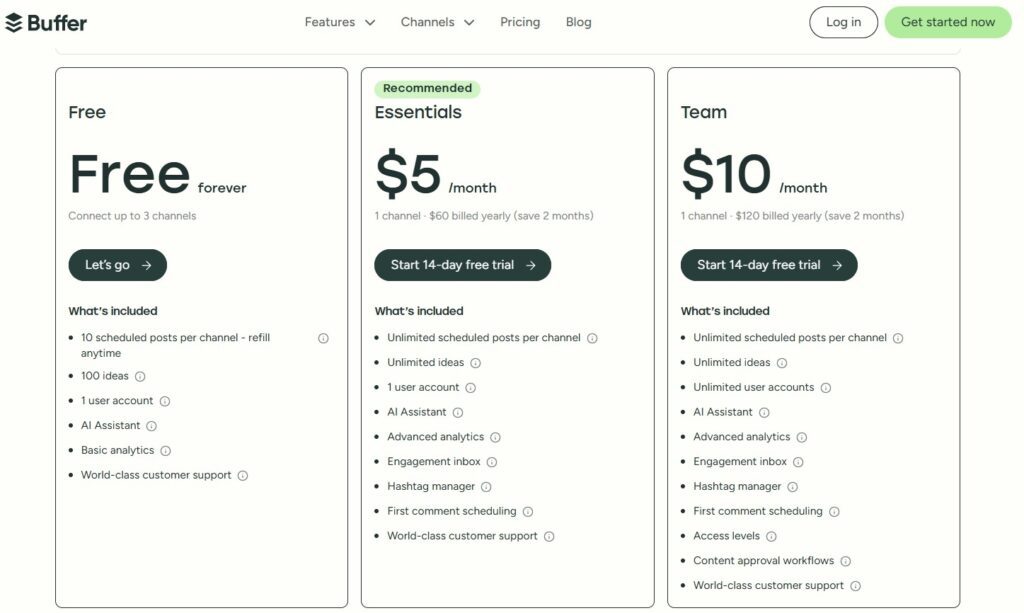
However, if you already are deft at using these social media platforms and have been using them for quite a while now and is looking for a upgrade, prefer Hootsuite for its robust features and advanced analytics as it is ideal for managing multiple clients or larger teams. It’s a powerful all-in-one solution for pros who need more than just basic scheduling.
| Feature | Buffer | Hootsuite |
|---|---|---|
| Free Plan | Yes (lifetime, limited features) | 30-day free trial only |
| Ease of Use | Very beginner-friendly | Steeper learning curve |
| Social Accounts Limit | 3 on free plan | 3 on free plan |
| Post Scheduling | Up to 10 posts per account (Free) | Unlimited with paid plans |
| User Interface | Clean and minimal | Feature-rich but cluttered |
| Analytics | Basic (advanced on paid) | Advanced analytics even on lower tiers |
| Best For | Beginners and solo creators | Agencies and marketing teams |
| Starting Price (Paid)* | $5/month per channel | $22/month (Professional plan) |
Disclaimer: The information provided in the comparison charts in the article is based on current available data and is subject to change. Readers are advised to visit the official websites of the respective tools/software to verify the most up-to-date pricing, features, and plans before making any decisions.
These tools even offer analytics so you can see what content performs best, helping you refine your strategy without constant manual tracking.
💡 Pro Tip: Use Buffer’s “Best Time to Post” feature to schedule content when your audience is most active.
Using an Affiliate Marketing System (Software Tools)
In 2025, a complete affiliate marketing system includes features like link tracking, commission reporting, campaign management, and even fraud prevention — all in one dashboard.
👉 “Automation is powerful, but it all starts with your site’s design. I’ve put together a list of beginner-friendly WordPress themes on Envato that work perfectly for affiliate sites.”
Platforms like Scaleo or ShareASale allow you to manage your affiliate links, monitor conversions, and automate payouts and reporting. These tools are ideal if you’re managing a team of affiliates or want everything centralized.
💡 Pro Tip: Use Scaleo to set up real-time alerts for high-performing campaigns and detect low-converting links early.
Scaleo vs. ShareASale - Brief Comparison
| Feature | Scaleo | ShareASale (To be Awin) |
|---|---|---|
| Pricing | Starts at $1600/month (14-day free trial) | $59 per month + tracking fee ($0 joining fee) |
| Affiliate Tracking | Real-time tracking with customizable dashboards | Standard tracking with detailed reporting |
| Fraud Detection | Built-in AI-powered fraud detection | Manual fraud detection processes |
| Customization | Highly customizable interface and tracking parameters | Limited customization options |
| Integrations | Supports various integrations including CRMs and payment gateways | Integrates with popular e-commerce platforms |
| Support | 24/7 customer support with dedicated account managers | Email and phone support during business hours |
| Best For | Businesses seeking a customizable and scalable affiliate solution | Merchants looking for a network-based affiliate program |
Why I chose Scaleo & ShareAsale over other software?
Scaleo and ShareASale are not the only affiliate marketing tools available, but I selected some conspicuous factors as discussed below – “I will share a list of other popular affiliate marketing software as well, so that you can make a decision.:
✅ Here’s why these two were highlighted:
- Scaleo represents a modern affiliate management software built for brands and businesses that want a fully customizable and automated affiliate system.
- ShareASale is a well-established affiliate network that’s beginner-friendly and trusted by thousands of merchants and affiliates globally.
They cover two different use cases:
- One is for affiliate program owners (Scaleo),
- The other is for joining existing affiliate programs/networks (ShareASale).
Other Popular Affiliate Marketing Tools (2025)
If you’re looking for more options, here are a few other legitimate tools:
| Tool | Purpose |
|---|---|
| Tapfiliate | Create and manage your own affiliate program |
| PartnerStack | B2B partner and affiliate program platform |
| Post Affiliate Pro | Affiliate tracking software for ecommerce |
| Refersion | Track referrals and influencer marketing |
| CJ Affiliate (formerly Commission Junction) | Large affiliate network |
| Rakuten Advertising | Trusted affiliate network with global reach |
Content Curation & SEO Automation
Coming up with fresh content ideas and optimizing it for search can be exhausting — but it doesn’t have to be.
Use tools like Feedly or Pocket to automatically gather trending articles and ideas in your niche. Then, apply SEO automation using tools like Ahrefs, SEMrush, or Surfer SEO to find the best keywords and track performance without manual digging.
Feedly vs. Pocket
| Feature | Feedly | |
|---|---|---|
| Pricing | Free trial. Pro plan $5-$8 per month. | Free; Pocket Premium at $5/month |
| Content Discovery | Yes, with AI (Leo) suggestions | Basic save-for-later; no AI curation |
| Categories/Tags | Yes, with custom feeds and boards | Tagging system available |
| Offline Access | Limited | Available in Premium |
| Integrations | Slack, Trello, Zapier, Evernote, etc. | Evernote, Twitter, and email |
| Best For | Marketers and content creators | Readers and researchers |
Ahrefs vs. SEMrush - Short Comparison
| Feature | Ahrefs | SEMrush |
|---|---|---|
| Pricing | Starts at $129/month | Starts at $139.95/month |
| Keyword Research | Excellent keyword explorer | Powerful keyword magic tool |
| Backlink Tracking | Best-in-class | Very good |
| Site Audit | Yes, with health score | Yes, with detailed insights |
| Competitor Analysis | In-depth | Advanced tools with SERP history |
| Best For | SEO professionals, backlink research | All-round digital marketing analysis |
💡 Pro Tip: Set up keyword alerts in Ahrefs to notify you when competitors rank for specific terms.
Link Management & Tracking
Affiliate links can get messy, especially if you’re juggling multiple products and platforms. Tools like Pretty Links or Bitly help you create clean, branded, and trackable URLs.
You can also track clicks, see geographic data, and update links across all your content without having to manually replace them.
Pretty Links vs. Bitly
| Feature | Pretty Links | Bitly |
|---|---|---|
| Pricing | Starts at $99/year (WordPress plugin) | Free plan; Paid from $10/month |
| Custom Domains | Yes | Yes |
| Analytics | Detailed click tracking & conversion | Real-time link analytics |
| Integrations | WordPress, Zapier, CRM tools | Zapier, HubSpot, Salesforce, etc. |
| UTM Support | Yes | Yes |
| Best For | WordPress site owners & bloggers | Marketers, agencies & enterprises |
💡 Pro Tip: Use Pretty Links’ automatic link replacement to turn every mention of a product into a clickable affiliate link.
Chatbots & Customer Interaction
When visitors hit your site, don’t let them bounce without engaging. Tools like ManyChat or Drift (now Salesloft) can automate conversations, offer product suggestions, collect emails, or answer basic questions in real-time — even while you sleep.
ManyChat vs. Drift
| Feature | ManyChat | Drift |
|---|---|---|
| Pricing | Free plan; Pro from $15/month | Free (limited). Not much information on the paid plans as their paid plans vary from $125 to $165 per user per month, or around $2,000 per user per year, depending upon factors like team size, features required, etc. |
| Platforms | Facebook Messenger, Instagram, SMS | Website, chat, email |
| Automation | Visual flow builder, lead gen tools | Conversational marketing & routing |
| CRM Integration | Shopify, HubSpot, Mailchimp, Zapier | Salesforce, Marketo, HubSpot |
| Use Case | Small businesses, creators | Enterprise B2B marketing |
| Best For | Lead nurturing & simple funnels | Sales teams & high-value lead gen |
💡 Pro Tip: Set up a chatbot to ask a qualifying question and then deliver a personalized affiliate offer based on the response.
Retargeting & Paid Ads Automation
Running paid ads manually can eat up hours and still miss the mark. Tools like Facebook Ads Manager and AdEspresso let you automate targeting, split tests, and budget allocation based on performance data.
Retargeting visitors who didn’t convert the first time can significantly increase your affiliate commissions, especially when it’s running 24/7 in the background.
Facebook Ads Manager vs. AdEspresso
| Feature | Facebook Ads Manager | AdEspresso |
|---|---|---|
| Pricing | Free to use (ad spend only) | From $49/month |
| A/B Testing | Manual setup | Built-in and user-friendly |
| Automation | Rules-based (if/then) automation | Advanced ad optimization rules |
| Reporting | Integrated reports and dashboards | Visual and downloadable reports |
| Learning Curve | Moderate | Beginner-friendly |
| Best For | DIY marketers | Agencies & those managing many campaigns |
💡 Pro Tip: Use dynamic retargeting ads to show visitors the exact product pages they viewed.
CRM Integration for Affiliate Funnels
A CRM (Customer Relationship Management) tool helps you track every lead from the moment they sign up to the point they convert — and beyond. Platforms like HubSpot or Salesforce allow you to automate follow-ups, segment leads by behavior, and even assign scores to prioritize hot prospects.
HubSpot vs. Salesforce
| Feature | HubSpot CRM | Salesforce |
|---|---|---|
| Pricing | Free CRM; Paid plans from $15/month | Paid only; Starts at $25/month/user |
| Automation | Workflows in Marketing/Sales Hubs | Advanced automation with Flows |
| Affiliate Funnel Use | Email sequences, deal tracking | Custom funnel building & lead scoring |
| Integrations | 1,000+ integrations (Zapier, Gmail) | 3,000+ integrations |
| Ease of Use | Very user-friendly | Steep learning curve |
| Best For | Startups and SMEs | Large enterprises and sales teams |
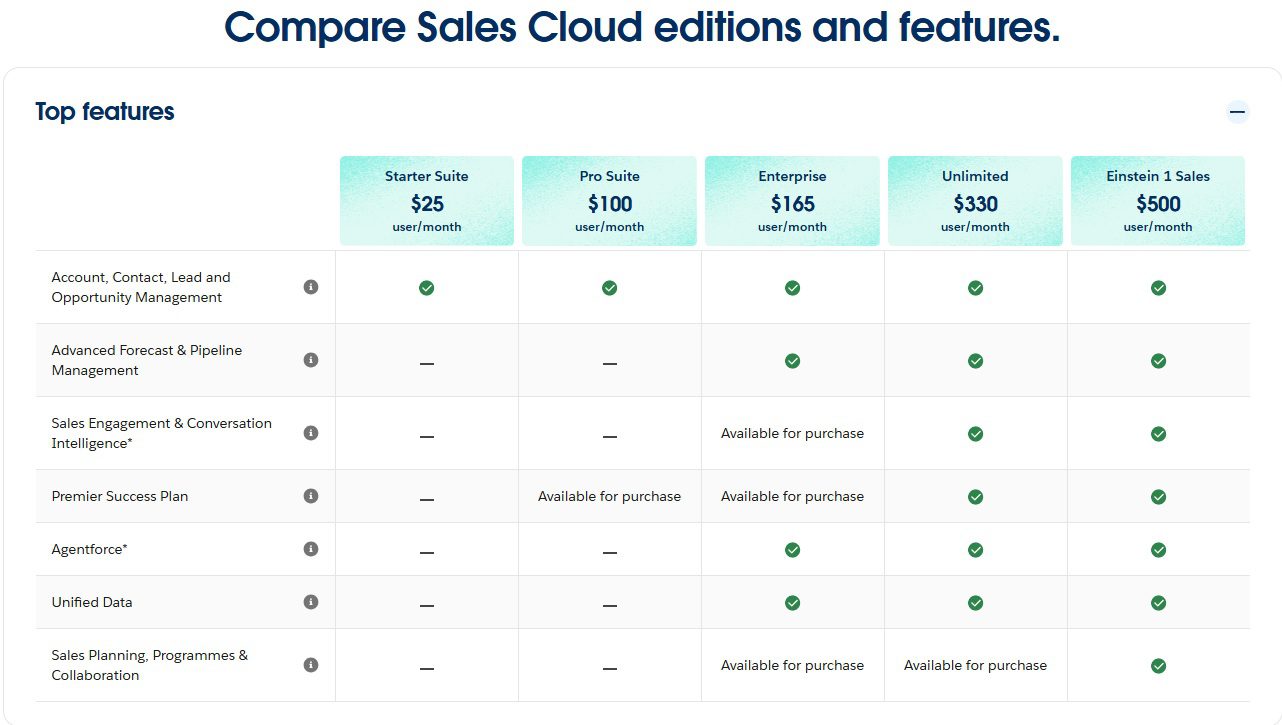
💡 Pro Tip: Integrate your CRM with your email and sales tools for a seamless, automated affiliate funnel.
Analytics & Performance Dashboards
You can’t improve what you don’t measure. Tools like Google Analytics, Tableau, or DashThis help you create automated dashboards that show real-time insights into your traffic, conversions, and ROI.
These platforms pull data from multiple sources and display it in one place, helping you make smarter decisions without manual number-crunching.
Google Analytics vs. Tableau vs. DashThis
| Feature | Google Analytics (GA4) | Tableau | DashThis |
|---|---|---|---|
| Pricing | Free | Public version free; Pro from $70/user | Starts at $42/month |
| Custom Dashboards | Yes | Yes (very advanced) | Yes (pre-set and customizable widgets) |
| Ease of Setup | Medium complexity | Complex for beginners | Very easy with templates |
| Data Sources | Website, app, ad platforms | Almost any source via connectors | 34+ integrations |
| Reporting | Real-time + historical | Visual storytelling with data | Executive summaries |
| Best For | General analytics for all levels | Data analysts & enterprises | Agencies & marketers needing quick insights |
💡 Pro Tip: Use DashThis to create a weekly performance dashboard that gets sent to your inbox automatically.
Full Funnel Automation – A 2025 Gamechanger
Full-funnel automation refers to the seamless integration of automation tools and workflows at every stage of the affiliate marketing journey — from a user’s first interaction with your content to the moment you earn a commission.
In 2025, this approach is a game-changer. Why? Because it allows you to scale your affiliate business without losing touch with the user experience.
Imagine this:
A visitor discovers your blog via Google (thanks to automated SEO tools), signs up through a lead magnet (triggering an email sequence), clicks on an affiliate link (tracked in real-time), and makes a purchase. Their payment is processed via Stripe or Paddle, and you get your commission — all without manual input.
🔁 Full-funnel automation = continuous, hands-free income generation.
From attraction → engagement → conversion → tracking → payout, everything can now be systemized using:
- Tracking tools like ClickMagick or Thrive Tracker
- Email tools like ConvertKit
- Checkout & payout solutions like Stripe, Paddle, or even PayKickstart
💡 Pro Tip: Set up automated alerts to notify you when a certain product link surpasses a click or conversion threshold — this allows you to double down on what works.
Best Practices for Automation in Affiliate Marketing
Automation is powerful, but with great power comes great responsibility. The key to success isn’t just setting things on autopilot — it’s doing it smartly.
✅ 1. Smart Automation ≠ Spammy Automation
Avoid generic blast emails or robotic chatbot replies. Users can spot automation from a mile away, and nothing turns them off faster. Quality beats quantity.
✅ 2. Use Behavioral Triggers & Personalization
Tailor your automations based on user actions, not assumptions. For example:
- If someone clicks on an affiliate link but doesn’t buy, send a follow-up with FAQs or reviews.
- If a subscriber downloads a lead magnet about SEO tools, funnel them into a sequence about the best SEO software with affiliate links.
Tools like ActiveCampaign, Drip, or HubSpot make this easy.
✅ 3. Keep Everything User-Focused
Every automation should add value. Whether it’s an email, chatbot message, or retargeting ad — ask yourself: “Does this help the user make a better decision?”
Automation isn’t about removing the human touch — it’s about amplifying it efficiently.
✅ 4. Embrace Omnichannel Automation
Don’t rely on just one platform. Your audience might engage with you through:
- Messenger
- Your blog
- YouTube
Using platforms like Zapier, Make.com, or Pabbly, you can connect these channels and create a consistent, personalized experience — wherever your audience is.
💡 Pro Tip: Create an automation where a new blog subscriber is also added to your Facebook Custom Audience for retargeting. That’s omnichannel in action.
Top Tools to Automate Affiliate Marketing (2025 Edition)
Here’s a quick-reference table of some of the most powerful tools affiliate marketers are using in 2025 to automate key processes:
| Tool | Purpose |
|---|---|
| Mailchimp | Email automation, nurturing sequences |
| ActiveCampaign | Behavioral email triggers & CRM |
| Scaleo | Affiliate tracking & campaign management |
| ClickFunnels | Landing page creation & funnel building |
| Buffer | Social media scheduling & automation |
| Hootsuite | Cross-platform social scheduling |
| Feedly | Content curation & idea generation |
| Ahrefs | SEO automation & keyword tracking |
| Pretty Links | Link cloaking & click tracking |
| Bitly | Short, trackable affiliate links |
| ManyChat | Automated chatbot marketing |
| AdEspresso | Facebook & Instagram ad automation |
| HubSpot | CRM & omnichannel marketing automation |
| Paddle | Payment processing & affiliate payouts |
| Google Analytics | Traffic insights & conversion tracking |
| DashThis | Visual performance dashboards |
| Zapier | Automation across multiple tools |
Benefits of an Automated Affiliate Marketing System
Automating your affiliate marketing doesn’t just make things easier — it fundamentally transforms the way you grow and scale your business. Here are the biggest advantages:
✅ Time-Saving
No more wasting hours on repetitive tasks like sending emails, checking clicks, or scheduling social posts. Automation frees you up to focus on what matters most.
✅ Scalable
Want to promote 10 products or 100? Automation allows you to grow without burnout. Whether you’re handling one campaign or dozens, your systems can handle the load.
✅ Smarter Decisions via Data
With analytics tools and performance dashboards, automation turns guesswork into strategy. You can instantly know which products are converting, which channels are working, and what needs attention.
✅ Focus on Strategy, Not Operations
When your operations run on autopilot, you can step back and look at the big picture — testing new niches, building partnerships, or creating higher-converting funnels.
🔁 In 2025, the winners in affiliate marketing won’t be the ones working harder — they’ll be the ones automating smarter.
Conclusion: Is Automation the Future of Affiliate Marketing?
Looking back at my own journey, I can confidently say that automation has totally revolutionized online affiliate marketing. I used to spend hours manually scheduling posts, sending out emails one by one, and trying to make sense of link performance across spreadsheets. It was exhausting — and honestly, not very scalable. But once I started using automation tools, things started to click. Not overnight, but steadily and sustainably.
So, is automation the future of affiliate marketing? Without a doubt — yes. But let’s be clear: automation isn’t some magical “set and forget” button. You still need to bring the strategy, the creativity, and the human touch. You must scratch your head and then make a blueprint of your strategies before you see your efforts bring you fruitful results. Think of automation as your assistant — not your replacement.
– Start small. Maybe it’s setting up your first email sequence or connecting your social accounts to Buffer. Whatever your current setup, there’s an automated way to do it smarter. You don’t need to overhaul your entire system today — just commit to taking that first step.
Because in 2025, the affiliates who automate smartly will be the ones scaling efficiently and sleeping peacefully. Ready to be one of them?
FAQs
What is the easiest way to start automating affiliate marketing as a beginner?
The easiest way to begin is by automating your email marketing. Tools like Mailchimp or ConvertKit offer beginner-friendly templates and pre-built workflows that guide your subscribers from interest to conversion — all on autopilot.
Can I automate affiliate marketing without a website?
Yes, while having a website helps, you can still automate parts of your affiliate strategy using email funnels, social media automation tools, and platforms like Gumroad or Medium, combined with shortened affiliate links.
How much does it cost to automate an affiliate marketing system?
Costs vary depending on the tools you choose. You can start with free or freemium tools like Buffer or Mailchimp, but for a full-fledged setup, expect to invest anywhere from $50–$200/month on automation tools for emails, tracking, CRMs, and SEO.
Is “AI” necessary to automate affiliate marketing in 2025?
AI isn’t mandatory, but highly beneficial. AI tools can personalize content, optimize campaigns, and even predict user behavior. They’re especially useful for email automation, chatbots, and analytics — helping affiliates save time while increasing conversions.
Do automated affiliate systems work for all niches?
Absolutely! Whether you’re in health, tech, fashion, or digital tools, automation enhances efficiency across all niches. The key is customizing your workflows and tools to suit your audience’s behavior and content preferences.

